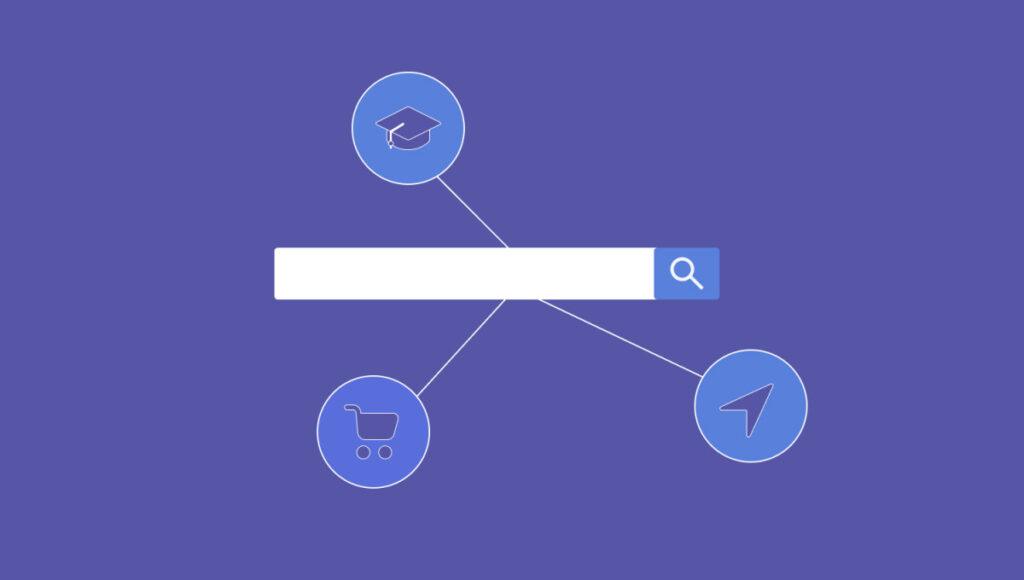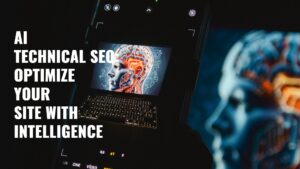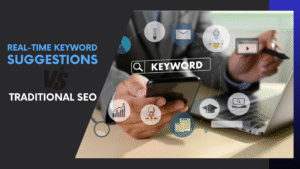In digital marketing, understanding what users really want when they type a query into Google is the key to SEO success. But with billions of searches happening daily, how can businesses accurately interpret search intent at scale? This is where AI in search intent classification comes into play.
AI-powered algorithms are revolutionizing how search engines and marketers analyze, categorize, and respond to search intent. By leveraging machine learning and natural language processing (NLP), AI can detect whether a user is looking for information, trying to make a purchase, or simply navigating to a specific website. The result? More accurate keyword targeting, better content alignment, and skyrocketing SEO performance.
In this article, we’ll explore how AI-driven search intent classification works, the key benefits of AI-powered search intent, and how to improve SEO with AI-driven search intent strategies. Ready to unlock the full potential of AI for SEO? Let’s dive in!
What Is Search Intent and Why Does It Matter?

When users type a query into Google, they have a specific goal in mind—whether it’s finding information, purchasing a product, or navigating to a particular website. This goal is what we call search intent. Understanding search intent is the foundation of effective SEO because Google prioritizes relevance when ranking pages. If your content doesn’t align with user intent, it won’t rank—no matter how well-optimized it is.
Types of Search Intent
To fully grasp the search intent classification benefits, we must first break down the four main types of search intent:
- Informational Intent – The user is looking for information.
- Example: “What is AI in search intent classification?”
- Content type: Blog posts, guides, how-tos.
- Navigational Intent – The user wants to find a specific website or page.
- Example: “Google Search Console login”
- Content type: Homepage, landing pages.
- Transactional Intent – The user is ready to take action, such as making a purchase.
- Example: “Buy AI-powered SEO tools online”
- Content type: Product pages, sales landing pages.
- Commercial Intent – The user is researching before making a decision.
- Example: “Best AI tools for understanding search intent”
- Content type: Reviews, comparison articles.
Why Search Intent Matters for SEO Success
Search intent is the driving force behind SEO rankings and user engagement. Google’s algorithms, powered by AI for understanding search intent, analyze queries to ensure that search results match the user’s intent. Here’s why this matters for your SEO strategy:
- Increases Click-Through Rate (CTR): When your content precisely matches user intent, it gets more clicks.
- Reduces Bounce Rate: If users find relevant answers instantly, they stay longer.
- Boosts Conversions: Targeting transactional and commercial intent increases sales.
How AI Improves Search Intent Classification
Before AI, marketers relied on manual keyword analysis to predict user intent. Now, AI in search intent classification automates this process by:
- Analyzing search patterns to detect intent-driven behavior.
- Using NLP to interpret queries in different contexts.
- Improving SEO with AI-driven search intent classification, helping businesses create hyper-targeted content.
The Role of AI in Search Intent Classification
The ability to correctly interpret user intent is a game-changer for SEO, and AI in search intent classification is making this process faster, more precise, and scalable. Traditional keyword analysis often fails to capture the true intent behind a search query, leading to irrelevant results and lost opportunities. AI, however, can analyze vast amounts of search data, detect intent patterns, and refine search results dynamically.
How AI Deciphers Search Intent
Modern search engines, including Google, leverage AI-driven models like BERT (Bidirectional Encoder Representations from Transformers) and RankBrain to understand the nuances of search intent. Here’s how AI processes search queries:
- Natural Language Processing (NLP): AI uses NLP to analyze search terms, understanding context, synonyms, and variations of a phrase.
- User Behavior Analysis: AI examines click patterns, dwell time, and engagement rates to infer intent.
- Query Classification Models: AI categorizes search queries into informational, navigational, transactional, or commercial intent automatically.
For example, a query like “best AI tools for understanding search intent” signals commercial intent, prompting AI-driven systems to prioritize comparison articles, reviews, and tool recommendations over generic informational content.
Why AI is Transforming Search Intent Classification
The benefits of AI for understanding search intent extend beyond search engines—businesses, content creators, and marketers can all leverage AI to enhance SEO strategies. Here’s how:
- More Accurate Content Recommendations – AI ensures users see content that precisely matches their intent, improving engagement.
- Better Keyword Targeting – AI detects emerging search trends, allowing businesses to optimize for intent-driven keywords.
- Improved Ad Targeting – AI refines PPC campaigns by ensuring ads are shown to users with high purchase intent.
Case Study: AI in Search Intent at Work
Google’s BERT update significantly improved search intent classification benefits by:
- Enhancing the ability to understand long-tail queries.
- Improving search accuracy for conversational and voice searches.
- Prioritizing context over exact-match keywords making AI-driven intent classification essential for SEO success.

Key Benefits of AI-Powered Search Intent Classification
The rise of AI in search intent classification has revolutionized how businesses, marketers, and search engines understand user behavior. By leveraging AI-powered insights, companies can deliver content that aligns perfectly with search intent, resulting in better SEO rankings, higher engagement, and improved conversion rates. Let’s explore the top benefits of AI-powered search intent classification and how it enhances digital marketing strategies.
1. More Accurate Keyword Targeting
Before AI, keyword research was primarily based on search volume and competition metrics. However, this approach often led to content that didn’t fully match user expectations.
- AI detects search patterns, user behavior, and contextual relevance to refine keyword targeting.
- AI-based tools like Google BERT and RankBrain analyze search queries beyond exact keyword matching, prioritizing intent-based results.
- Marketers can now optimize content based on intent-driven keywords rather than just high-volume search terms.
For example, a query like “best AI for understanding search intent” signals commercial intent, prompting AI systems to rank product comparisons and reviews higher than general informational content.
2. Improved Content Relevance and SEO Rankings
One of the biggest search intent classification benefits is ensuring that the content served to users precisely matches their intent.
- AI-powered tools help content creators identify intent gaps and structure content accordingly.
- NLP (Natural Language Processing) allows AI to understand synonyms, context, and long-tail queries, improving content relevance.
- When content aligns perfectly with user intent, search engines reward it with higher rankings and increased organic traffic.
For instance, if a user searches for “how AI improves SEO rankings,” AI-driven search engines will prioritize blog posts and guides over product pages because the user intent is informational, not transactional.
3. Higher Engagement and Lower Bounce Rates
AI-driven search intent classification enhances user experience by delivering precisely what users are looking for.
- Matching search intent correctly leads to longer dwell times, higher engagement, and lower bounce rates.
- AI optimizes content recommendations, ensuring that users stay on a website longer and explore related pages.
- Search engines like Google use engagement metrics (time on page, click-through rate, bounce rate) as ranking factors—AI-powered content optimization improves all three.
By improving SEO with AI-driven search intent classification, businesses create a better user experience while securing top positions in search results.
4. Enhanced Ad Targeting and Conversion Rates
AI isn’t just transforming organic search—it’s also reshaping paid search and PPC (pay-per-click) advertising.
- AI identifies high-intent users and targets them with hyper-personalized ads.
- AI-powered ad platforms like Google Ads and Meta Ads automatically adjust bids and targeting strategies based on search intent.
- Businesses can now reduce ad spend waste by only showing ads to users with transactional or commercial intent, leading to higher conversion rates.
For example, a user searching for “buy AI-powered SEO tools” has clear purchase intent. AI-driven ad targeting ensures they see the most relevant product ads, increasing the likelihood of a sale.
5. AI-Powered Predictive Analytics for Future SEO Strategies
AI doesn’t just analyze current search intent—it predicts future trends and emerging search behaviors.
- AI-powered tools analyze historical search data to forecast upcoming SEO trends.
- Businesses can proactively create content that anticipates user needs, giving them a competitive edge.
- AI-driven insights help brands stay ahead of search algorithm updates, ensuring continued SEO success.
How AI Helps in Understanding Search Intent Better
The role of AI in search intent classification goes beyond simple keyword analysis. AI-powered tools leverage machine learning, natural language processing (NLP), and deep learning to interpret the true intent behind user queries. This enables search engines, marketers, and businesses to deliver the most relevant content, improve SEO rankings, and enhance user experience.
1. AI-Powered Natural Language Processing (NLP)
Search intent isn’t always obvious. AI uses NLP to interpret search queries, even when they’re phrased in complex or conversational ways.
- Understands synonyms and contextual meaning (e.g., “best AI tools” vs. “AI tools for ranking higher”).
- Processes voice search and long-tail queries, which are often phrased as questions (e.g., “How can AI help with search intent classification?”).
- Detects sentiment and intent nuances—whether a user is researching, comparing, or ready to buy.
For instance, Google’s BERT update significantly improved search intent classification benefits by enhancing Google’s ability to interpret natural language and return more relevant search results.
2. AI Learns from User Behavior and Engagement
AI doesn’t just analyze keywords—it also studies how users interact with search results to refine intent classification.
- Click-through rates (CTR): If users frequently click on a specific type of content (e.g., product reviews for “best AI SEO tools”), AI learns that this content type best matches intent.
- Dwell time & bounce rate: If a user quickly leaves a page, AI interprets this as a poor intent match and adjusts search rankings accordingly.
- Search refinements: AI tracks how often users modify their queries, signaling whether initial results failed to meet intent.
By leveraging AI-driven user behavior analysis, search engines continuously improve their ability to match content to intent, boosting SEO accuracy.
3. AI Enhances Semantic Search for Better Intent Recognition
Google’s search algorithms are now semantic-based, meaning they focus on meaning rather than exact keyword matches.
- AI connects related concepts, ensuring users get contextually relevant results.
- Search engines understand intent-based relationships—e.g., a search for “how to improve SEO rankings” may return guides, checklists, and AI-powered SEO tools instead of just keyword-stuffed articles.
- AI-powered topic modeling helps businesses create comprehensive, intent-driven content that ranks higher.
By improving SEO with AI-driven search intent classification, marketers can optimize their content for meaning and relevance rather than just keyword density.
4. AI Adapts to Search Trends in Real Time
Traditional SEO strategies often rely on historical keyword data, which can become outdated quickly. AI, on the other hand, continuously learns from real-time search trends and user behavior.
- AI-powered tools like Google’s RankBrain dynamically adjust SERP rankings based on fresh data.
- AI can identify seasonal trends, viral topics, and emerging search patterns, allowing businesses to stay ahead of competitors.
- Real-time AI updates ensure that content remains highly relevant, even as user search behavior evolves.
For example, during the rise of ChatGPT and AI content tools, AI-driven search algorithms quickly adjusted rankings to prioritize new, authoritative content on the topic.
5. AI-Powered Content Optimization for Search Intent
With AI, businesses no longer need to guess what type of content will rank—AI-powered tools provide data-driven insights to optimize content for specific intent types.
- AI-driven content analysis tools (like Clearscope, SurferSEO, and MarketMuse) recommend what keywords, topics, and formats best match search intent.
- AI helps businesses create intent-aligned content, ensuring their pages rank higher and attract engaged audiences.
- AI-powered content audits identify intent mismatches, helping businesses refine existing content for better search performance.
By leveraging AI-powered search intent analysis, marketers save time, increase accuracy, and ensure their content resonates with the right audience.

How to Improve SEO with AI-Driven Search Intent Strategies
Integrating AI in search intent classification has transformed SEO, enabling businesses to align content precisely with user needs. By leveraging AI for understanding search intent, companies can enhance their SEO strategies effectively. Here’s how to implement AI-driven search intent strategies to boost your SEO performance:
1. Utilize AI-Powered Tools for Keyword Research
Traditional keyword research focuses on search volume and competition. AI-powered tools, however, analyze user behavior, context, and intent to identify high-value keywords that align with what users are genuinely seeking.
Action Steps:
- Employ AI-driven keyword research tools to discover intent-based keywords.
- Focus on long-tail keywords that reflect specific user intents, as they often have lower competition and higher conversion rates.
2. Optimize Content for User Intent
Understanding the different types of search intent—informational, navigational, transactional, and commercial—is crucial. AI helps in identifying these intents, allowing you to tailor your content accordingly.
Action Steps:
- Analyze search queries to determine the predominant intent.
- Create content that directly addresses the identified intent, ensuring it meets user expectations.
3. Implement Structured Data and Schema Markup
AI-powered search engines rely on structured data to understand and categorize content effectively. Implementing schema markup enhances content visibility and relevance in search results.
Action Steps:
- Use appropriate schema types (e.g., Article, Product, FAQ) to provide context to your content.
- Ensure structured data is correctly implemented and validated to improve search engine comprehension.
4. Leverage AI for Content Creation and Optimization
AI tools can assist in generating content ideas, optimizing existing content, and ensuring alignment with user intent. This enhances relevance and engagement.
Action Steps:
- Utilize AI-driven content platforms to analyze top-performing content in your niche.
- Optimize content structure, readability, and keyword placement based on AI recommendations.
5. Monitor and Adapt to AI Search Algorithm Changes
AI-driven search algorithms evolve continuously. Staying informed about these changes and adapting your strategies ensures sustained SEO success.
Action Steps:
- Regularly monitor SEO performance metrics to identify shifts in search patterns.
- Be prepared to adjust content and SEO tactics in response to algorithm updates.
Final Thoughts on Enhancing SEO with AI-Driven Search Intent Strategies
Embracing AI in search intent classification empowers businesses to create content that resonates with users and aligns with search engine algorithms. By focusing on user intent and leveraging AI tools, you can enhance your SEO strategy, improve search rankings, and provide valuable content that meets user needs.


